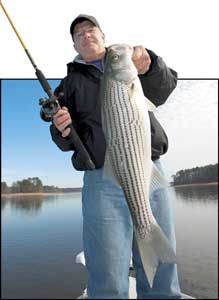
Spring is an exciting time to be at a lake searching for striped and hybrid bass activity as they migrate from the rivers and creeks back into the main lake channels.
Whether you prefer to drift, use drop lines or troll, using live bait consistently catches more striped and hybrid bass than artificial lures or baits. But like everything else in fishing and in life, there’s a right and a wrong way of going about things.
Here are nine useful guidelines for using live baits for striped and hybrid bass.
1) Use only the freshest bait in the bait-tank bucket or live well.
Live bait works so well because, well, it’s alive.
When scooping out or catching live minnows and shiners from the bait tank, the slower and more lethargic will be the easiest to capture. They may be the easiest to catch and put on a hook, but they won’t provoke the most strikes. The best baits are the lively and difficult little critters.
2) Hook your bait just below the dorsal fin or through both lips.
A common mistake is hooking live bait through the eyes — which prevents the baitfish from seeing a big striper as it approaches. A big striped bass that’s stalking a live minnow or shiner will cause it to get excited and jumpy.
This often triggers a desperate predatory response from the striper resulting in a quick strike. But a blind minnow doesn’t know it’s being stalked and will just sit there and enjoy the ride — and won’t attract as many fish.
3) After you begin fishing with live bait, check them often to be sure they’re still fresh and lively.
A minnow or shiner that’s been dragged around the lake for an hour is probably more dead than alive.
If you’re like me, I feel my time fishing is too valuable to be doing it with dead or near-dead baits.
4) Big baits catch fewer, larger fish; smaller baits catch smaller but more fish.
Determine the strategy of your fishing trip and use the appropriate-size baits.
Mixing up sizes of baits will clue you as to what size the fish prefer that day. If you’re trophy hunting, roll the dice with larger shiners.
5) Use a round or oval bait tank.
Minnows and shiners tend to congregate in the oxygen-depleted corners of a square or rectangular tank, resulting in many more dead or lethargic baitfish.
A round or oval-shaped tank also reduces the chance of the bait swimming into the sides and becoming injured or weakened.
6) Add non-iodized salt to the tank water to help harden the scales on your baitfish and make them last longer.
One-quarter cup on non-iodized salt for every 2- gallons of water is just about right.
7) During particularly hot days, keep the water in the bait tank cool.
The best way to accomplish this is by freezing water in milk jugs then submerging the frozen jugs into the bait tank.
Adding ice directly into the water can import impurities and cause a drastic change in water temperature, causing the baitfish to go into shock and die.
8) Only use a hook size proportional to the size of the baitfish you’re using.
If you use a hook size that is too small, you’ll get fewer hook-ups. Use a hook that’s too big, and it will inhibit the action of your baitfish and produce fewer strikes.
9) Never handle livebaits with dry hands.
Dry hands remove the slime and scales, damaging the bait’s effectiveness. The easy solution is to simply wet your hands before attempting to bait your hook with the bait.
All of these tips have basically the same goal — keeping your live baitfish looking fresh and lively as long as possible.
If not, you lose the basic advantage of using live baits in the first place.
By following these simple but effective guidelines, you will increase your success ratio and make your next striper or hybrid bass fishing trip an enjoyable one.



Be the first to comment